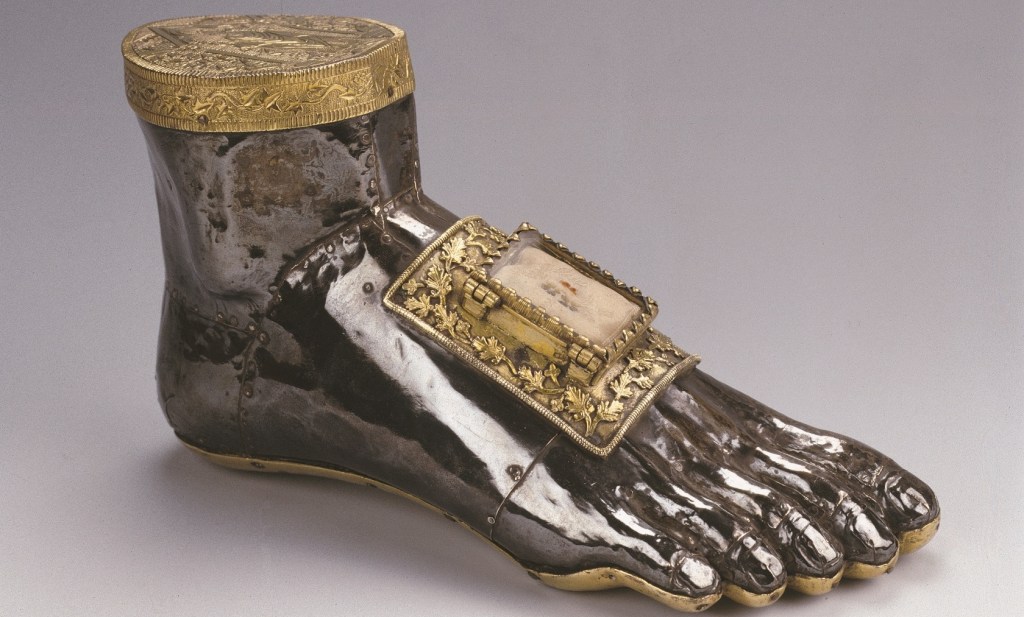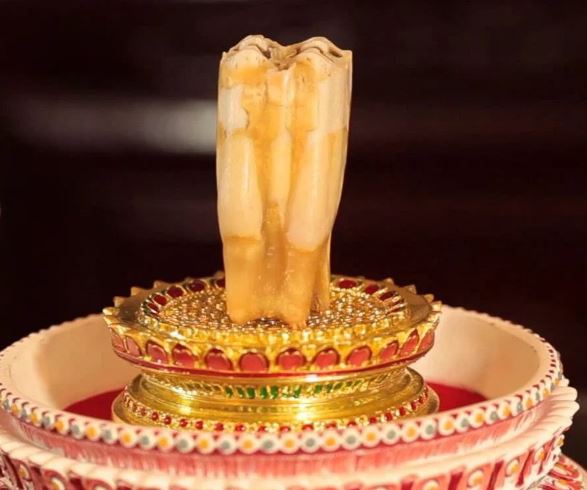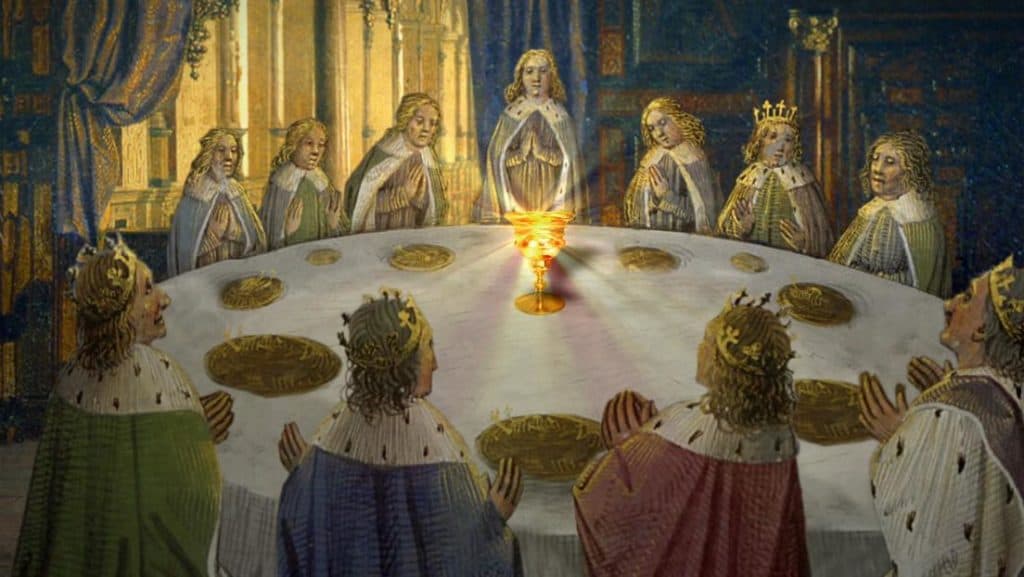Lichfield, Staffordshire. November, 2022
I dressed in sober clothes, as if for a funeral, which in a way it was, then made my way to the cathedral – to find it alight with candles and full of people, all there for an extraordinary event: the Reception of a Relic of St Chad, a fragment of leg bone, carbon-dated to the right period, which may or may not have belonged to the 7th century saint who came from Northumbria to preach peace in the battle-scarred kingdom of Mercia.
The service was very Popish, with much processing about by dignitaries and clergy, great crosses held aloft in air scented by the ‘holy smoke’ of incense. Then the case containing the relic was placed in its new shrine and all the important people present bowed their heads before it. I’d expected a fancy box of some kind, but the reliquary was a small, cross-like affair, the bone itself barely visible, set in a roundel. A faint brown shadow, like a desiccated cornflake.
There were other relics in this cathedral once; the Sacrist’s Roll of 1345 lists ‘divers items’, including the skull of St Chad, housed in its own chapel, a splinter from the cross of St Peter and – my favourite – ‘some of the dust of St Amphibalus.’
All long gone, lost to the Reformation, when prayers were only to be addressed to God, the sole maker of miracles. But the people missed the saints they saw as bridges between heaven and earth, who could intercede for sinners in times of need. And the attraction to the worldly remains or possessions of holy persons – and their grip on our imagination – has never gone away…
In 2016, the elbow of St Thomas a Becket was returned to Canterbury, while only last autumn, the kneecaps and other bits of St Bernadette left Lourdes to go on tour in England, Scotland and Wales. Wherever the relics paused and were put on display, thousands of visitors flocked to see them – in a modern echo of all the mediaeval pilgrims who travelled to places associated with popular saints, here and abroad. Journeys good for the soul, innkeepers along the way – and the charlatan.
Relics were high demand. Churches that housed important examples in shrines and altars attracted a lot of people and money to a town and put it forever on the map. The trade in counterfeit pieces was rife and roundly condemned at the time; the pilgrims in Chaucer’s Canterbury Tales of1392 were prey not only to the Plague but to smooth-talking tricksters happy to sell such ‘souvenirs’ to the gullible. Animal bones were easy to pass off as segments of some saintly skeleton…
In a world where life was so short and pain had little remedy, something seen as sanctified held out hope of protection or cure. It might even be a shield against the wages of sin and the horrors of hell. For even the sophisticated soul, it was worth taking a chance on truth.
In literate, ecclesiastical circles, some relics had a higher status than others. Anything associated with Christ’s life and death, like pieces of the Manger or the Cross were ‘first-class’ relics, as were a martyr’s mortal remains, while personal belongings – like a rosary, glove or a book – were ‘second-class’…
The belief in the sacred and secular value of such objects had huge cultural consequences. In a pre-scientific age, it was hard to tell the real from the fake, but once identified as authentic by the church authorities – however insecurely – the relic had to be preserved, stored and made ready for display. So the relic required a reliquary – a container befitting its contents. The decaying flesh, the broken bone, the handful of dust weren’t much to look at, after all; they must be transformed,rendered near-invisible, made beautiful. The superior reliquary was to be jewelled and made in precious metals – often gold, because it did not tarnish, and ivory, its pallor implying purity. The object of devotion became a work of art, a process of preservation in itself. I saw over a hundred such artifacts once, gathered together under one roof, in an exhibition about religious relics at the British Museum.
Treasures of Heaven,. Autumn, 2011
Some were ‘speaking’ reliquaries, shaped to resemble the body part they contained. Like the 13th silver case in the form of a foot, the real one within once attached to St Blaise. Most of the exhibits left me cold, but others were too eloquent to forget. Like the fragile items associated with the only saint in the Church of England: Charles the First. Scraps, not of the King himself, but of the bloodstained silk shirt he wore on the scaffold in January, 1649 – and the single pearl earring said to be his favourite.
The light was low and people whispered their way around the exhibition. One of them, thinking herself unobserved and her lips moving in prayer, leant over one of the display cabinets, then kissed the glass. For her, the bone hidden in a golden box mattered more than any devout agnostic could imagine.
Such power! That such a thing – a fragment of doubtful origin – could speak so to someone’s soul. And not only here but all over the world – like the Temple of the Tooth in Sri Lanka, which enshrines a dental relic of the Buddha retrieved from his funeral pyre in 543 BC. Or the Topkapi Palace in Istanbul, home to hair from the beard of the Prophet Muhummad.
A very down-to-earth friend of mine finds this kind of thing ‘ rather creepy… all this fuss about bits of dead people!’ She sees the relic as belonging to the dark ages and a superstitious past, its influence bestowed upon it from outside, by the beholder, then and now. To other minds, there’s a power residing in the relic itself. If genuine and imbued with the spirit of the holy person, it was a worthy focus of veneration. If inauthentic, maybe it didn’t matter. For The Unknown Visitor at the exhibition, the object of her attention was no museum piece but an article of faith, whatever its provenance. When Sister Wendy Becket said, ‘ something can be holy in its meaning, if not in actuality,’ she touched on one of the most elusive of phenomena, the nature of belief…
In the early centuries AD, however, the provenance of relic was all-important. For a Roman empress called Helen, (c. 248 – 330) the mother of Constantine, the pieces of the Cross she found in Jerusalem were evidence of an unquestioned truth. This was the relic not as the subject of debate it would later become, but as inanimate ‘witness’ to what happened and as such a way of spreading the ‘cult’ of Christianity.
Other ‘original’ relics were lost in legend long ago. Once, the cup held in His hand at the Last Supper was a solid vessel later to become more idea than object, the symbol of eternal quest for something that can never be found. A Holy Grail.
So many mysteries attend the relic’s route through time, but the word itself is a bedrock. Relic comes from the Latin relinquere, to leave behind, and reliquiae, what remains…. Objects with a puzzling or tragic past always command attention, because they’re still there when so much has vanished – and tap into the quality that makes us uniquely human. Curiosity, the wondering what lies beneath the surface – of the field or the flesh, the sea or the rubble. The Neanderthal rib, the Saxon brooch, the coin, the ruins of an abbey… And yet what remains may not be ancient at all, but recovered from a still recent past.
Twenty-two years ago, an American and I had a conversation that came close to ending the friendship – about 9/11 and how people were clamouring for what the New York Post described at the time as ‘sacred relics’ – things once part of the lives of people they did not know and could never mourn. He found this deeply upsetting and disrespectful of the dead.
‘Material salvaged from Ground Zero.’ Not the thousands of pieces of twisted steel and concrete and shards of glass, but everyday items that spoke of the people lost that day. Bicycles still chained to their racks, crushed office furniture, melted computers….
For most of the ‘collectors’, the motive may well have been a morbid or commercial one, but maybe for others, I suggested – safe across the pond -it was a way of trying to understand the horror in human terms. He knew I felt for him and his city, but it was a clumsy response to an experience still raw and it was months before we spoke again.
I saw pictures later of other items from the wreckage. A briefcase, a shoe, pages from a diary, with burnt edges. Very personal effects, belonging to victims never found or identified, so un-returned to friends or family. This is a precious bridge we rarely think about – the one that unites the things that inhabited a person’s life with his or her name.
How natural it is to honour what helps us relate to the past or keep a personal memory alive. Things we can have and hold or at least approach in a museum…that connect us to what we believe in or to those we cherish but can no longer touch. It’s not such a long step from St Blaise’s foot to the ashes in an urn or the curl of hair in a Victorian locket or a letter written in the trenches. Or the milk teeth my down-to-earth friend keeps in a little glass jar. The unlovely term relic has a beautiful sister – remembrance.
Note: If you like this post, you might also like no.5 (The Souvenir), no 18,(The Signature)no 39 (Touch) and no.49 (Teeth). There’s a wonderful book about relics: Holy Bones, Holy Dust, by Charles Freeman. I’d love to know what you think about the subject!




This is so interesting and thought-provoking. Do people have a “favourite” relic? Mine is the Shroud of Turin. Is this the cloth St. Veronica used to wipe the face of the suffering Jesus. I like to think so. As usual I have learned about things I did not know and found it quite fascinating.
LikeLike
A wonderfully written piece with feelings and understanding.
LikeLike
Again, such a good read. I knew it was going to be a good article when I read about the “desiccated cornflake”. What an amazing image!
Thanks Tessa. More please!
LikeLike